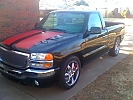Was reading one of Banish's books this morning and there was a line that stuck out at me: "The spark map should look like an inverse of the volumetric efficiency map". This sounds like a viable alternative for dyno tuning to me.
Now, from what I remember of math vocabulary, inverse means opposite. Where I am stumped is in how to make the spark table look like an inverse of the VE Table and what data to log and how to log it to get the data I need to achieve this. Any pointers would be appreciated.






 Reply With Quote
Reply With Quote


 I always felt street tuning to be an essential part of the tuning process.
I always felt street tuning to be an essential part of the tuning process.